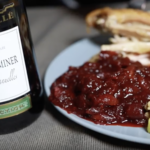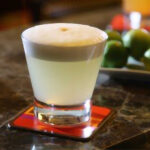
Turkey has a rich culinary tradition; Turkish flatbread making and coffee culture are on the World’s Intangible Cultural Heritage list. The variety of regional dishes in Turkey is vast, but most people don’t get much further than kebab and baklava. It’s not surprising because many Turkish dishes look rather daunting to the uninitiated, and not everyone likes to dive in without knowing what to expect. I know I don’t, but after living in Istanbul on and off for almost ten years, there aren’t too many things I haven’t tried at least once. Here are ten unusual Turkish regional dishes to try, all readily available in Istanbul if you know what to look for and what you’re looking at.
Künefe
Künefe is a dessert made of twisty strands of wiry pastry called tel kadayıf, soaked in cheese and honey and cooked in a flat dish over a high heat. It’s known all over the Middle East and there are endless variations. The tastiest Turkish one hails from Hatay and is influenced by the Syrian cuisine of Aleppo. The type of cheese and butter used in the dough are very important. You can’t use just any cheese, but which is best is a secret künefe makers keep close to their chest. Künefe becomes slightly crunchy when cooked so when you bite into a piece it breaks apart, creating an unbelievable taste explosion of cheese and honey.
Pişmaniye
Izmit is home to a type of Turkish cotton candy known as pişmaniye. Made of sugar, water, lemon juice, butter and flour, it melts deliciously in your mouth. Yet this sugary concoction has a bitter past, if folklore is to be believed. Once upon a time a confectioner in Izmit had the entire city buying his extraordinarily good sweets. A beautiful curvaceous young woman came into his store and he fell madly in love with her. In order to woo her he invented a dessert he called Şişmaniye. Şişman means plump and was a compliment in traditional Turkish culture. The two married but sadly didn’t live happily ever after. His wife’s bad-temper caused the confectioner to rename the dessert pişmaniye, replacing his former adoration with the word pişman, meaning regret. Luckily for us the new name didn’t change the taste.

Içli köfte
Içli köfte, stuffed meatballs, are made from bulgur wheat compacted into a fine casing that’s filled with ground meat. The meat can be mixed with walnuts, pistachios, or pine nuts. The casing is closed up and the köfte deep fried. The form they take depends on where they’re made. The Hatay version is bullet shaped while the people of Gaziantep prefer theirs round. Whatever type appears on the menu, make sure you order at least one. Take care with that first bite though, the center can be piping hot!
Pestil
Best known for its apricots, Malatya is home to the most popular version of a healthy snack called pestil. It’s made by cooking apricots down to a pulpy mass that’s then spread thinly onto a sheet of cotton and left to dry. When it’s cooled and solidified the pestil is cut into smaller pieces. These chewy straps of sun dried fruit make great travel snacks and last for ages…or they do if you can stop at just one. Look out for them in spice shops and at street markets. Sometimes you can get pestil made from mulberries and grapes, studded with nuts or apricot kernels.
Manisa macunu
Manisa macunu, a sticky multi-colored toffee-like substance served on a stick, comes from Manisa, naturally. It was made as a restorative for Sultana Ayşa Hafsa, wife of Sultan Selim I, by a teacher and doctor named Merkez Muslihiddin Efendi in 1539. The Sultana had been unwell for some time, and after eating this paste comprising 41 natural herbs and spices sweetened with sugar, she was immediately returned to full health, or so they say. It’s believed to have numerous curative benefits—but be careful if you’re a single female and plan to stay that way. Adherents of the power of macunu believe you’ll marry within a year of eating it. If that happens make sure you have some Manisa macunu handy. It’s one of the oldest known aphrodisiacs and it tastes great too.

Kestane
When the days grow shorter and the temperature drops, smoke from roasting chestnuts fills the streets of Istanbul. Buy a paper cone of these fat globes of nutty flesh from a roaming vendor. Chestnut trees grow along the north coast of Turkey but the finest and most famous are found in Bursa. There they’re transformed into an indulgent sweet called Kestane Şekeri, sugared or candied chestnuts. The outer casing is peeled away and the inner blanched so the skin can be removed. Then the chestnuts are immersed in syrup and cooked over a low heat for several hours. Once cooled they make a mouth-wateringly decadent present to take home to loved ones. Kestane Şekeri are readily available in Şekerci, confectionary shops. The difficulty is getting the box home full and unopened.
Trabzon ekmek
The most popular souvenir to bring back from Trabzon is a huge chunky loaf of long lasting Vakfıkebir bread, better known as Trabzon Ekmek. Like many breads it’s made from flour, water and sour dough. What makes Trabzon Ekmekspecial is its size and consistency. A loaf can weigh up to sixteen pounds, is full of flavor and doesn’t mould easily so it’s good to eat even when it’s stale. It originates from the Vakfıkebir Black Sea district where it was first baked in stone ovens in 1897. Luckily, word of its superior qualities spread and it’s now available at bakeries in Istanbul and other major Turkish cities.
Tulum
Turkey boasts more than ten types of a buttery flavored crumbly cheese called tulum. The most popular is Şavuk Tulum from the city of Erzincan. The cheese is white or cream in color with a high fat content, but the word tulum refers to the use of goat skin in the maturation process. Once the cheese curd is ready it’s packed tightly into goat-skin bags and left to ripen for a few months in caves. The goat skins form part of the sales display, so don’t be surprised to see a hairy bag decorated with ribbons or beads in one of Istanbul’s many dairy stores.

Kokoreç
I’ll be honest. I’ve never actually tried kokoreç, sheep or goat intestines wrapped around sweetbreads and grilled on a vertical skewer, but my husband has. Apparently it goes down well after a night on the rakı, Turkey’s national aniseed alcoholic beverage. Kokoreç became known in Istanbul via Albanians working in city abattoirs in the 20th century. The Albanians specialised in organ butchery and the manufacture of edible offal products. Elsewhere in the country, in particular Izmir on the west coast, kokoreç was a favorite of the Rum people, Turkey’s Greek population. Once cooked, kokoreç is chopped up and mixed with oregano, hot chilli peppers and salt and eaten wrapped in bread. People say it’s delicious but it’s not for the faint-hearted. While it does smell great, when it comes to actually eating it…I’ll leave that for you to decide.
Bumbar
This speciality sausage comes from Siirt Provnce in south eastern Turkey. Cow intestine is thoroughly washed and stitched together to form a tube. It’s packed with rice, black pepper, parsley and thin slices of meat before being stitched together at either end. The completed sausage is boiled for about an hour and a half until cooked. Sometimes it’s left to rest for 30 minutes then served with a garlic sauce, other times it’s fried in butter. Even if you’re like me and offal isn’t your thing, it’s really worth trying. I have. Trust me.
Now that you’re an expert in regional Turkish cuisine you can confidently eat your way around Turkey without ever having to leave Istanbul. Afiyet olsun! (That’s Turkish for bon appetit!)

Lisa Morrow is a Sydney born sociologist, travel writer, and author of three books about her life and travels in Istanbul and Turkey. She lives in Istanbul and writes about food, wine, culture and travel for print magazines and websites. When Lisa isn’t writing she’s sampling as many different types of red wine as possible, trying to learn Portuguese and daydreaming about her next travel destination.



